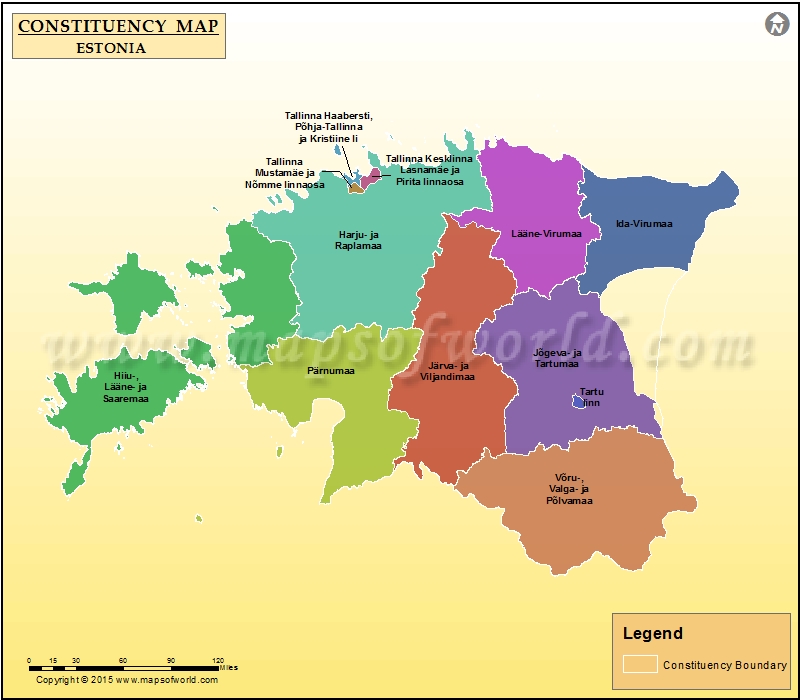Map of Elections in Estonia 2015

On 1st March, 2015, Estonia elects members to the XIII Parliament. Estonia follows a unicameral structure of Parliament, also known as Riigikogu, which comprises of 101 seats.
Estonia is holding due elections, after a political turmoil in 2014, which saw the then Prime Minister Andrus Ansip resign, after heading a coalition government for nine years. Post his resignation, a new coalition government was formed with the coming together of Estonian Reform Party (RE) and Estonian Social Democrats (SDE) and headed by Prime Minister Taavi Rõivas, who took office on 24 March 2014.
The current government is headed by President Toomas Hendrik IIves but the position is largely ceremonial, with no executive powers. The Riigikogu is responsible for legislation and also elects the President and appoints the Prime Minister and the Chief Justice of the Supreme Court. The Riigikogu is currently presided by Eiki Nestor, who took office in March 2014.
In the last Riigikogu elections held in 2011, 789 persons ran as candidates, of which 757 candidates were nominated by 9 political parties and 32 individuals stood as independent candidates. The voter turnout was 63.5%.
The political break-up of the current session in the Riigikogu is divided between the ruling coalition and opposition. Out of a total of 101 seats (51 seats needed for majority), the ruling Coalition has 52 seats, while the Opposition controls 49 seats. The break-up of seats for the ruling coalition is RE (33 seats), SDE (19 seats) ; the opposition break-up is IRL (22 seats), KE (21 seats).
Election History
Estonia has practiced democracy for a long time, with the first Estonian Constituent Assembly having its opening session on 23 April 1919. The first elections to the Riigikogu was held in 1920 and saw five elections till 1938. Between 1938 and 1940, the Riigikogu was bicameral and comprised of two chambers; The Chamber of Deputies and the National Assembly.
However, with the former Soviet Union taking over Estonia, the Riigikogu was replaced with the Supreme Soviet of the Estonian Soviet Socialist Republic from August 25, 1945 till 1990.
When Estonia broke free from the Soviet Union in 1991, the Supreme Council of the Republic of Estonia took over under the Chairmanship of Arnold Rüütel on March 29, 1990. In September 1992, Estonia held its first elections to the Riigikogu, under the new Constitution of Estonia.
Election System
101 members representing 12 multi-member constituencies are elected following the proportional representation based on D’Hondt method of vote. They must pass a nationwide minimum threshold of 5%.
Election Process
Any candidate above the age of 21 can stand for elections to Riigikogu, while the minimum age is 18 years, for the local government council elections. A candidate has to be nominated from a political party or in the case of independent candidates, they may nominate themselves. For the Riigikogu elections, all candidates must submit a security deposit which is two times the monthly salary at the Riigikogu elections.
All voters are issued a Voter Card and the same must be presented at the time of voting. On registration of details, the voter card may be sent to voters physically or can be requested electronically.
As per the Referendum Act and other election acts, Estonia allows for Advance Voting for its citizens, especially those living overseas. Voting booths are established at consulates and are open between the 10th and 7th day, prior to Election day.
Voters also have the option to undertake I-voting, wherein a voter may cast his vote through the internet, after completing the due verification process. Internet voting was first carried out for local elections in 2005, for Riigikogu in 2007 and the European Parliament elections in 2009 and 2014. In the 2011 Parliament elections, 140,764 voters cast the votes through I-voting.
There are 12 electoral districts for electing members to the Riigikogu.
Political Parties
The major political parties in 2011 Riigikogu elections to get passed the minimum 5% threshold were Estonian Reform Party, Estonian Centre Party, Pro Patria and Res Publica Union and the Social Democratic Party. Three parties that could not qualify the 5% threshold were; Estonian Green Party, People’s Union of Estonia and Others.
Candidates
Some of the prominent candidates for the 2015 Riigikogu elections are likely to be Taavi Rõivas (current PM), Edgar Saavisar, Urmas Reinsalu, Sven Mikser, Jaanus Tamkivi, Kadri Simpson, Kaia Iva, Karel Rüütli, amongst several others.